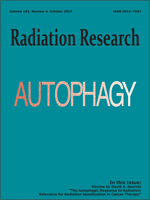An interesting problem associated with studying the effects of low doses of high atomic number and energy (HZE) particles, as found in space, is that not all cells will necessarily be similarly traversed during exposure, a scenario that greatly complicates the measurement of end points that require time to develop, gene-locus mutation being a perfect example. The standard protocol for measuring mutations at the heterozygous thymidine kinase locus in human lymphoblastoid cells involves waiting three days after treatment for newly induced mutants to fully express, at which time cells are then plated in the presence of the selective agent, and mutants are counted three weeks later. This approach is acceptable as long as all cells are uniformly affected, as is the case with low-linear energy transfer (LET) ionizing radiation. However, for HZE particles some fraction of cells may not be traversed or perhaps would receive fewer than the average number of “hits”, and they would continue to grow at or closer to the normal rate, thus outpacing cells that received more damage. As a result, at three days post-treatment, more heavily damaged cells will have been “diluted” by the less damaged ones, and thus the measured mutant frequency (MF) will underestimate actual mutant frequency. We therefore developed a modified approach for measuring mutation that eliminates this problem and demonstrates that the mutagenicity of 1 GeV/n Fe ions are underestimated by a factor of two when using the standard MF protocol. Furthermore, we determined the mutagenic effects of a variety of heavy ions, all of which induced mutations in a linear fashion. We found that the maximal yield of mutations (i.e., highest relative biological efficiency) was about 7.5 times higher at an LET of 70 keV/μ (400 MeV/n Si) than for gamma rays. Nontargeted mutagenicity after treatment with ionizing radiation was also investigated. For each particular ion/energy examined and in agreement with many previous studies, there was no clear evidence of a dose response for bystander mutagenesis, i.e., the MF plateaued. Interestingly, the magnitudes of the bystander MFs induced by different ion/energy combinations did vary, with bystander MFs ranging from 0.8 to 2.2× higher than the background. Furthermore, the nontargeted MFs appeared to reflect a mirror image of that for direct mutagenesis.
How to translate text using browser tools
3 September 2014
Radiation Quality and Mutagenesis in Human Lymphoblastoid Cells
Howard L. Liber,
Rupa Idate,
Christy Warner,
Susan M. Bailey
ACCESS THE FULL ARTICLE

Radiation Research
Vol. 182 • No. 4
October 2014
Vol. 182 • No. 4
October 2014




